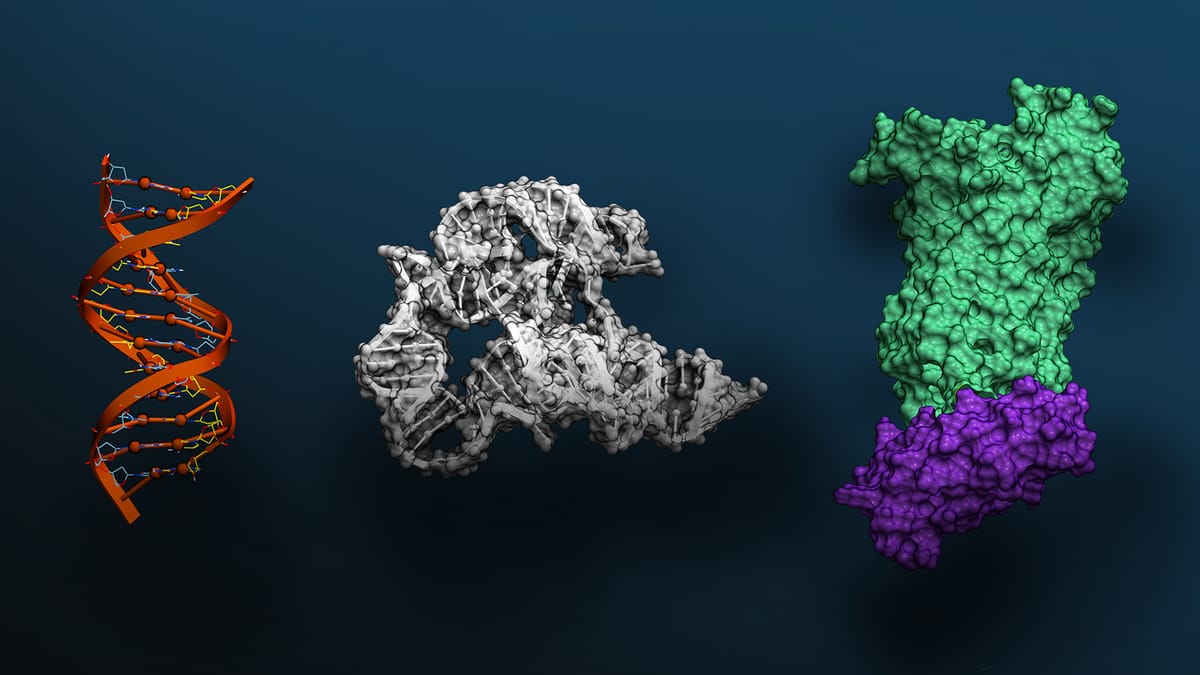NVIDIA has unveiled Evo 2, a cutting-edge AI model poised to revolutionize genomic research. Developed in collaboration with the Arc Institute, Evo 2 leverages an unprecedented dataset of 9 trillion nucleotides to unlock new insights into the complexities of biomolecular systems. Available on the NVIDIA BioNeMo platform, Evo 2 promises to significantly accelerate discoveries in healthcare, biotechnology, and beyond, marking a pivotal moment in the application of AI to the life sciences. This development signifies a major step towards AI-driven drug discovery, personalized medicine, and a deeper understanding of the human genome.
Understanding the Power of Evo 2
Evo 2 represents a significant leap forward in AI-driven genomic research. Its ability to process and analyze vast amounts of genomic data surpasses previous models, offering researchers a powerful tool to:
- Identify disease-causing genes: Pinpoint specific genetic variations responsible for various diseases.
- Predict protein structures: Accurately model the three-dimensional structures of proteins, crucial for understanding their function.
- Design novel therapeutics: Develop targeted therapies by understanding the interplay between genes, proteins, and biological pathways.
- Personalize medicine: Tailor treatments based on an individual's unique genetic makeup.
The sheer scale of Evo 2's training dataset—9 trillion nucleotides—is a key factor in its enhanced performance. This massive dataset allows the model to learn complex patterns and relationships within the genome that would be impossible to discern with smaller datasets.
The NVIDIA BioNeMo Platform: Democratizing Access to AI
A critical aspect of Evo 2's impact is its availability on the NVIDIA BioNeMo platform. BioNeMo is a cloud-based platform designed to accelerate drug discovery and development by providing researchers with access to a suite of powerful AI models and tools.
By making Evo 2 available on BioNeMo, NVIDIA is democratizing access to this groundbreaking technology. Researchers, regardless of their computational resources or AI expertise, can leverage Evo 2 to accelerate their genomic research. This democratization has the potential to unleash a wave of innovation and discovery across the life sciences.
Key Features of BioNeMo
The NVIDIA BioNeMo platform offers several key features that make it an invaluable resource for genomic researchers:
- Pre-trained AI models: Access to a library of pre-trained AI models, including Evo 2, optimized for various biomolecular applications.
- Scalable infrastructure: Cloud-based infrastructure that can handle the computational demands of large-scale genomic analyses.
- User-friendly interface: Intuitive tools and workflows that simplify the process of training, fine-tuning, and deploying AI models.
- Collaboration tools: Features that facilitate collaboration among researchers, enabling them to share data, models, and insights.
In-Depth Look at Evo 2's Architecture and Training
To fully appreciate the significance of Evo 2, it's essential to delve into its underlying architecture and training methodology. While specific details may be proprietary, we can infer certain aspects based on NVIDIA's public statements and general principles of AI model development.
Transformer-Based Architecture
It's highly likely that Evo 2 utilizes a transformer-based architecture, a type of neural network that has proven remarkably successful in natural language processing (NLP) and, increasingly, in genomics. Transformers excel at capturing long-range dependencies within sequential data, making them well-suited for analyzing the complex relationships within the genome.
Self-Supervised Learning
Given the vast amount of unlabeled genomic data available, Evo 2 likely employs self-supervised learning techniques. In self-supervised learning, the model is trained to predict masked or corrupted portions of the input data. For example, the model might be trained to predict a missing nucleotide in a DNA sequence or a missing amino acid in a protein sequence. By learning to reconstruct the original data, the model develops a deep understanding of the underlying patterns and relationships.
Scalable Training Infrastructure
Training a model as large as Evo 2 requires significant computational resources. NVIDIA's expertise in GPU-accelerated computing is undoubtedly a key enabler. The company's high-performance GPUs and optimized software libraries allow researchers to train large AI models much faster than would be possible with traditional CPUs. The BioNeMo platform provides the necessary infrastructure for researchers to scale their training workloads and accelerate the development of new AI models.
Applications of Evo 2: Transforming Healthcare and Biotechnology
Evo 2's potential applications are vast and far-reaching. It promises to transform various aspects of healthcare and biotechnology, including:
- Drug Discovery: Identifying novel drug targets, predicting drug efficacy, and designing personalized drug therapies.
- Disease Diagnosis: Developing more accurate and earlier diagnostic tests for various diseases.
- Personalized Medicine: Tailoring treatments based on an individual's unique genetic makeup.
- Agricultural Biotechnology: Improving crop yields, developing disease-resistant crops, and enhancing the nutritional value of food.
- Synthetic Biology: Designing and engineering new biological systems for various applications.
Case Studies and Examples
While specific case studies involving Evo 2 are likely still under development, we can draw parallels from other AI-driven genomic research to illustrate its potential impact. For example, AI models have already been used to:
- Predict protein structures with unprecedented accuracy: DeepMind's AlphaFold model has revolutionized structural biology by accurately predicting the three-dimensional structures of proteins.
- Identify novel drug targets for cancer: AI models have been used to identify new drug targets for cancer by analyzing vast amounts of genomic and proteomic data.
- Accelerate the development of vaccines: AI models have been used to design and optimize vaccines for various infectious diseases.
Evo 2, with its enhanced capabilities and access through BioNeMo, is poised to accelerate these types of discoveries and unlock new possibilities in healthcare and biotechnology.
The Ethical Considerations
As with any powerful technology, Evo 2 raises important ethical considerations. It's crucial to address these considerations proactively to ensure that the technology is used responsibly and for the benefit of all.
- Data Privacy: Protecting the privacy of individuals whose genomic data is used to train and validate AI models.
- Bias: Ensuring that AI models are not biased against certain populations or groups.
- Accessibility: Making sure that the benefits of AI-driven genomic research are accessible to all, regardless of their socioeconomic status or geographic location.
- Transparency: Promoting transparency in the development and deployment of AI models.
NVIDIA and the Arc Institute have a responsibility to address these ethical considerations and to work with stakeholders to develop guidelines and best practices for the responsible use of Evo 2.
The Future of AI in Genomics
Evo 2 represents a major step forward in the application of AI to genomics, but it's just the beginning. The future of AI in genomics is bright, with the potential to:
- Develop more sophisticated AI models: AI models will continue to improve in accuracy, efficiency, and interpretability.
- Integrate diverse data types: AI models will be able to integrate diverse data types, such as genomic, proteomic, and clinical data, to provide a more comprehensive understanding of biological systems.
- Automate drug discovery: AI models will be able to automate many aspects of the drug discovery process, from target identification to clinical trials.
- Enable personalized medicine at scale: AI models will be able to personalize treatments for millions of patients, improving outcomes and reducing healthcare costs.
Detailed Technical Specifications
To organize the key technical aspects, the following table summarizes the specifications of the Evo 2 model:
| Feature | Description |
|---|---|
| Model Name | Evo 2 |
| Developer | NVIDIA & Arc Institute |
| Data Source | Genomic Data |
| Training Data Size | 9 Trillion Nucleotides |
| Architecture | Transformer-Based (Likely) |
| Learning Paradigm | Self-Supervised (Likely) |
| Deployment Platform | NVIDIA BioNeMo |
| Primary Applications | Drug Discovery, Disease Diagnosis, Personalized Medicine |
This table provides a clear snapshot for readers, encapsulating the model’s core capabilities.
Conclusion and Q&A
NVIDIA's Evo 2, powered by 9 trillion nucleotides and accessible through the BioNeMo platform, marks a significant leap in AI-driven genomic research. Its potential to accelerate discoveries in healthcare, biotechnology, and personalized medicine is immense. However, responsible development and ethical considerations must guide its deployment. As AI continues to advance, its role in unlocking the secrets of the genome will only grow, promising a future where diseases are diagnosed earlier, treatments are more effective, and healthcare is truly personalized.
Q&A Section
- What is Evo 2?
Evo 2 is a cutting-edge AI model developed by NVIDIA and the Arc Institute for genomic research, leveraging 9 trillion nucleotides of data. - What is the NVIDIA BioNeMo platform?
BioNeMo is a cloud-based platform that provides researchers with access to pre-trained AI models and tools for drug discovery and development. - What are the potential applications of Evo 2?
Drug discovery, disease diagnosis, personalized medicine, agricultural biotechnology, and synthetic biology. - What type of AI architecture does Evo 2 likely use?
Transformer-based architecture, which is well-suited for capturing long-range dependencies in genomic data. - What is self-supervised learning?
A type of AI training where the model learns from unlabeled data by predicting masked or corrupted portions of the input. - What are some ethical considerations related to Evo 2?
Data privacy, bias, accessibility, and transparency. - What is the future of AI in genomics?
More sophisticated AI models, integration of diverse data types, automation of drug discovery, and personalized medicine at scale.


